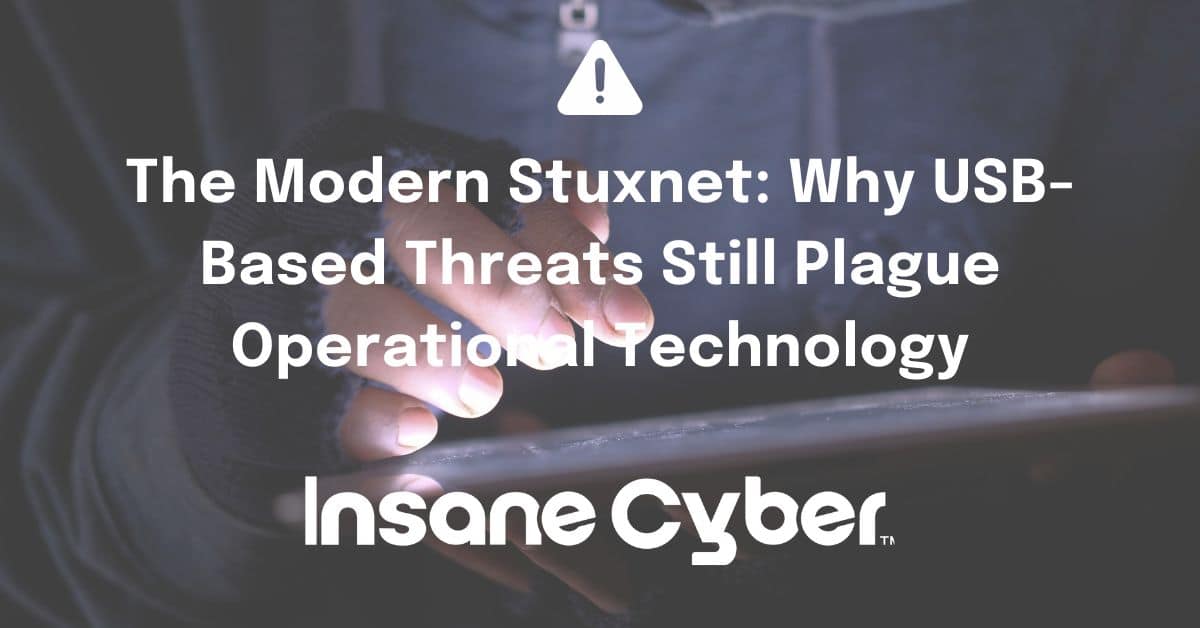USB Threats: The Perpetual Trojan Horse
In 2010, the world learned that a simple USB drive could deliver a cyber-physical strike so precise it could sabotage a nation’s nuclear program. That attack, Stuxnet, was a watershed moment.
Yet today, that same humble device remains the most effective Trojan Horse for breaching the “air-gapped” networks that power our lives—from the electricity in our homes to the water from our taps.
Despite billions invested in advanced digital defenses, this physical keyhole into our operational technology (OT) remains dangerously unlocked. This article is your guide to securing it. We will dissect the evolution of USB-based attacks, from Stuxnet’s sophistication to today’s commoditized malware, and provide a comprehensive framework for building true resilience at the industrial edge.
You’ll get actionable policies, best-in-class tool recommendations, and the insights needed to transform your organization’s weakest link into a hardened defense.
Key Takeaways: The Unfiltered Truth
- The Enemy Within: Trusted engineers and third-party contractors are the primary vectors, unknowingly bridging the air gap with infected media.
- Attacks Have Evolved: The threat has morphed from targeted sabotage to widespread espionage, ransomware, and even physical hardware destruction via USB.
- IT Tools Don’t Work Here: OT’s unique constraints—legacy systems, zero-downtime requirements, and specialized protocols—render traditional IT security tools ineffective or even dangerous.
- Proactive Defense is Non-Negotiable: You cannot afford to be reactive. A robust defense requires strict media policies, isolated scanning kiosks, and deep forensic capabilities.
#1. The Air Gap is a Myth: Why Physical Isolation Fails
The “air gap”—the deliberate physical separation of OT networks from corporate and external networks—has long been the bedrock of industrial security. But in practice, it’s more like a sieve than a wall.
- The Demands of Maintenance: How do you update firmware, transfer diagnostic logs, or install patches on an isolated machine? An engineer walks over with a USB drive. Every single time, this creates a potential bridge for threats.
- The Creep of Connectivity: The push for real-time data and IIoT analytics means more OT networks are being connected to corporate systems. These connections create hidden digital pathways that USB-borne malware can exploit to move laterally.
- The Human Factor: When security policies clash with the urgent need to keep a plant running, operators will almost always choose uptime. That shortcut—using a personal USB to transfer a critical file—is precisely the vulnerability attackers count on.
#2. A Vicious Evolution: From Stuxnet to Raspberry Robin
Stuxnet was a bespoke, state-sponsored weapon. Today’s USB threats are democratic, available to any cybercriminal with a goal. The timeline reveals a chilling trend from targeted sabotage to widespread, financially motivated crime.
|
Malware Family |
Year |
Target Environment |
USB’s Role |
|
Stuxnet |
2010 |
Siemens S7 PLCs (Iran) |
Primary Vector: Crossing the air gap via infected employee USBs. |
|
Industroyer |
2016 |
Ukrainian Power Grid |
Secondary Vector: Used for malware propagation on isolated ICS workstations. |
|
TRITON |
2017 |
Safety Instrumented Systems (SIS) |
Infection Vector: Flagged by FBI advisories as a likely method of entry. |
|
Copperfield |
2018 |
Middle East SCADA Systems |
Primary Espionage Tool: Delivered a RAT via USB to steal sensitive data. |
|
Raspberry Robin |
2021+ |
Global, including Oil & Gas |
Widespread Worm: Distributes malicious payloads; sold by initial access brokers. |
The lesson is clear: attackers no longer need a nation-state’s budget. They can buy access to your network from brokers who specialize in USB-based infiltration.
#3. Why Your IT Security Toolkit Will Fail in OT
You can’t simply deploy your corporate IT security stack in an OT environment. It’s like using a race car for off-road driving—it’s not built for the terrain and will likely cause a crash.
- Brittle, Legacy Systems: Many facilities still run on Windows XP or Windows 7, for which modern security agents aren’t designed. An incompatible agent could easily cause a blue screen, halting production.
- The Unforgiving Mandate of 100% Uptime: A crashed laptop in the corporate world is an inconvenience. A crashed HMI in a power plant is a crisis that can stop production and endanger lives.
- Chronic Lack of Visibility: Asset inventories in OT are often incomplete or outdated, and the specialized skills needed to manage them are scarce. You can’t protect what you can’t see.
Pro Tip: When you can’t patch the host or install an agent, you must rely on compensating controls. Isolated hardware used to scan and sanitize all removable media before it ever touches a critical asset is your most powerful defense.
#4. A Blueprint for a Bulletproof USB Security Program
A truly resilient program is built on three pillars: Policy, Process, and Technology.
Policy: The Rules of Engagement
- Strict Media Governance: Only company-approved, serialized, and centrally managed USBs are permitted. All others are “guilty until proven innocent.”
- Disable AutoPlay Globally: Use Group Policy (GPO) to turn off AutoRun and AutoPlay features on all Windows machines. This single step prevents a huge number of attacks.
- Physical Port Control: If a USB port isn’t needed, disable it in the BIOS or physically block it with port blockers or tamper-evident seals.
Process: Security as a Daily Habit
- Sanitization Stations: Establish a formal, mandatory process where all media must be scanned at a dedicated, isolated kiosk before being used in the OT environment.
- Digital Logs: Maintain an immutable log of every media insertion event: who, what, where, and when.
- Hyper-Realistic Training: Don’t just show slides. Run OT-specific awareness campaigns, including controlled “USB drop” tests to see who plugs in a found drive.
Technology: The Right Tool for the Job
Your choice of technology is critical. A one-size-fits-all approach is doomed to fail.
|
Solution |
Deployment Model |
Forensic Depth |
OT-Safe? |
Best For |
|
Endpoint Antivirus |
Host-based Agent |
Low |
No |
Basic IT environments, not for sensitive OT. |
|
IT USB Blocking |
Host/Network Agent |
None |
Risky |
Corporate policy enforcement, not threat detection. |
|
Fixed Scanning Kiosk |
On-Premise Station |
Medium |
Yes |
Securing facility entry/exit points for employees. |
|
Portable Scanning Kit |
Ruggedized Appliance |
High |
Yes |
Field engineers, contractors, and incident response teams. |
Solution Spotlight: A Portable Scanning Kit, like the Cygnet Flyaway Kit, is the gold standard for field operations. It’s a self-contained, ruggedized appliance that allows engineers to perform deep forensic analysis of any USB drive on-site before it’s plugged into critical equipment. It combines multi-engine malware scanning on a completely isolated platform.
#5. Field Guide: Threat Hunting & Incident Response
Assume a breach will happen. Your speed of response will determine the outcome.
What to Hunt For: The Telltale Signs
- Suspicious Executions: Look for msiexec.exe or rundll32.exe launching from unexpected locations or with strange command-line arguments.
- Hidden .LNK Files: Attackers use shortcut files (.LNK) hidden in the root of a USB to execute malicious scripts.
- Unauthorized HID Devices: Your system logs an unknown keyboard or network card being connected, even though it was a storage drive.
How to Respond: The First 60 Minutes
- ISOLATE: Disconnect the host from the network immediately, but do not turn it off. You need to preserve evidence in volatile memory.
- IMAGE: Use a trusted, dedicated forensic tool to create a bit-for-bit image of the suspect USB drive and the host machine’s hard disk.
- ANALYZE: Dump the system’s RAM to a file and analyze it for running malicious processes and injected code. This is where fileless malware lives.
- INVESTIGATE: Trace the root cause by examining registry keys, autorun entries, scheduled tasks, and event logs for signs of persistence.
- ERADICATE & RECOVER: Re-image the compromised host from a known-good gold image. Block any discovered command-and-control (C2) domains at your firewall. Learn from the incident and update your policies.
A well-rehearsed tabletop exercise covering a USB-based scenario is the difference between controlled response and chaos.
#6. The Road Ahead: Moving from Defense to Dominance
USB-borne threats are not going away. They are becoming stealthier, more automated, and more accessible. To stay ahead, your security posture must evolve from reactive defense to proactive anticipation.
- Embrace Behavioral Analytics: Move beyond signatures. Leverage tools that can detect anomalous device behavior—like a storage drive suddenly trying to act like a keyboard—before a payload executes.
- Foster Threat Intelligence: Actively participate in your industry’s ISAC (Information Sharing and Analysis Center). Your peers are your best source of intelligence on emerging TTPs.
- Continuously Harden: Security is a process, not a project. Re-evaluate your policies, test your response plans, and audit your controls quarterly.
Ready to put these principles into practice?
Download Our Free USB Threat Defense Playbook Get our 15-page guide complete with IOC lists, incident response checklists, and a step-by-step guide to deploying a secure media scanning program.
Conclusion: Taming the Trojan Horse
The humble USB drive remains the Achilles’ heel of OT security, a physical key to our most sensitive digital kingdoms. But it doesn’t have to be a liability.
By pairing rigorous policies with specialized, OT-safe technology and fostering a culture of vigilant awareness, you can transform this ubiquitous vector of attack into a controlled, auditable, and secure tool. The stakes—the reliability of our power grids, the safety of our water, and the integrity of our manufacturing—are too high to ignore. Secure this critical frontier and turn your biggest vulnerability into your first line of defense.
Further Reading & Next Steps
- Resources:
- Take Action:
-
- Request a Demo: See our Portable Scanning Kit in action and learn how it provides 100% safe, deep forensic analysis in the field.
- Download Our Free USB Threat Defense Playbook





